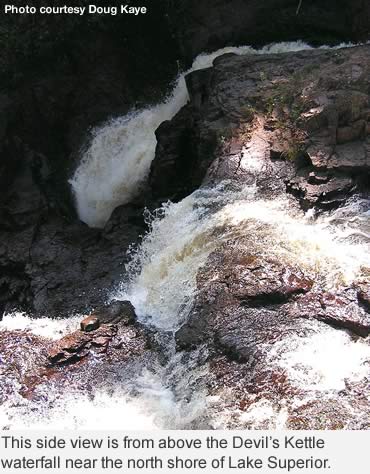Photo: Devil’s Falls is one of the most unusual waterfalls to be found anywhere. The falls split in two at the top, and one fork flows down the Brule River, while the other empties into a cauldron and seemingly disappears.
It was a geological mystery for the ages, an inexplicable puzzle as to why all the water from half a waterfall completely disappeared into a very deep hole.
High above Lake Superior and more than a mile inland, Devil’s Kettle waterfall on the Brule River near Grand Marais, Minnesota, is the most visited attraction at Judge C.R. Magney State Park. You will find the park some 300 miles south of the U.S. border with Ontario, Canada.
Visiting to see and hear the thunderous sound of the disappearing water has been on a must-do bucket list for generations of people who have watched the unusual waterfall with awe.
 In a deep canyon the river splits in two around a massive outcropping of rhyolite, a volcanic rock as hard as granite. The split created twin waterfalls, with the west side of the river disappearing into a deep hole, while the east half rushes over a rock ledge, loudly falling more than 50 feet into the river below.
In a deep canyon the river splits in two around a massive outcropping of rhyolite, a volcanic rock as hard as granite. The split created twin waterfalls, with the west side of the river disappearing into a deep hole, while the east half rushes over a rock ledge, loudly falling more than 50 feet into the river below.
Through the years, curious onlookers attempted to discover what happened to the water. They threw buoyant articles like sticks, ping pong balls, road signs and logs into hole where water disappeared, and hoped to find where those items reappeared downstream. But it never happened.
Others wondered if the water ended up in an underground river that led to Lake Superior, because they could never find an obvious place where the disappearing water resurged.
Geologists, however, dismissed underground river theories. Because underground waterways are formed in soft rock such as limestone, tunnels or lava tubes do not form in the rhyolite or volcanic basalt beneath the Brule riverbed.
It wasn’t until 2016 that scientists from the Minnesota Department of Natural Resources began the process to solve the ages old mystery and determine the exact nature of the disappearance of so much water.
Jeff Green, DNR springshed mapping hydrologist, and other scientists thought the water entering the Devil’s Kettle wouldn’t divert through a hidden channel to Lake Superior, but instead would resurface downstream in the river.
 To test the theory, he asked the DNR’s water monitoring and surveys unit to measure the volume of the water flowing above and below Devil’s Kettle with stream gauging equipment. By comparing the amount of water flowing above and below the falls, hydrologists would be able to determine if there was a loss of water between the two locations.
To test the theory, he asked the DNR’s water monitoring and surveys unit to measure the volume of the water flowing above and below Devil’s Kettle with stream gauging equipment. By comparing the amount of water flowing above and below the falls, hydrologists would be able to determine if there was a loss of water between the two locations.
The measured water flow above Devil's Kettle was at 123 cubic feet per second, while several hundred feet below the waterfall, the water flowed at 121 cubic feet per second.
"In the world of stream gauging, those two numbers are essentially the same, and are within the tolerances of the equipment," Green said. "The readings show no loss of water below the kettle, so it confirms the water is resurging in the stream below it."
But what about those disappearing ping pong balls, road signs and logs?
Calvin Alexander, one of Green’s colleagues at the University of Minnesota, said water force and fluid dynamics provide the explanation. “The plunge pool below the kettle is an unbelievably powerful system of recirculating currents, capable of disintegrating material and holding it under water until is resurfaces at some point downstream,” he said.
To many, the satisfaction of having the mystery solved by Green and his fellow hydrologists and biologists, is at long last, very welcome. Even if a few skeptics don’t want to believe their scientific explanation.
Resources — Minnesota Department of Natural Resources.